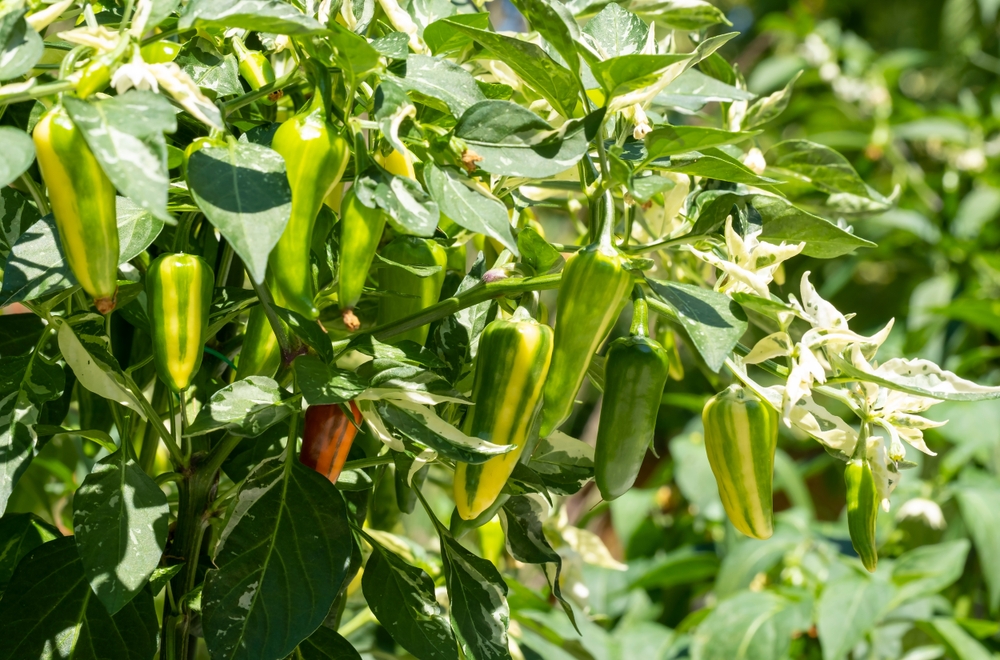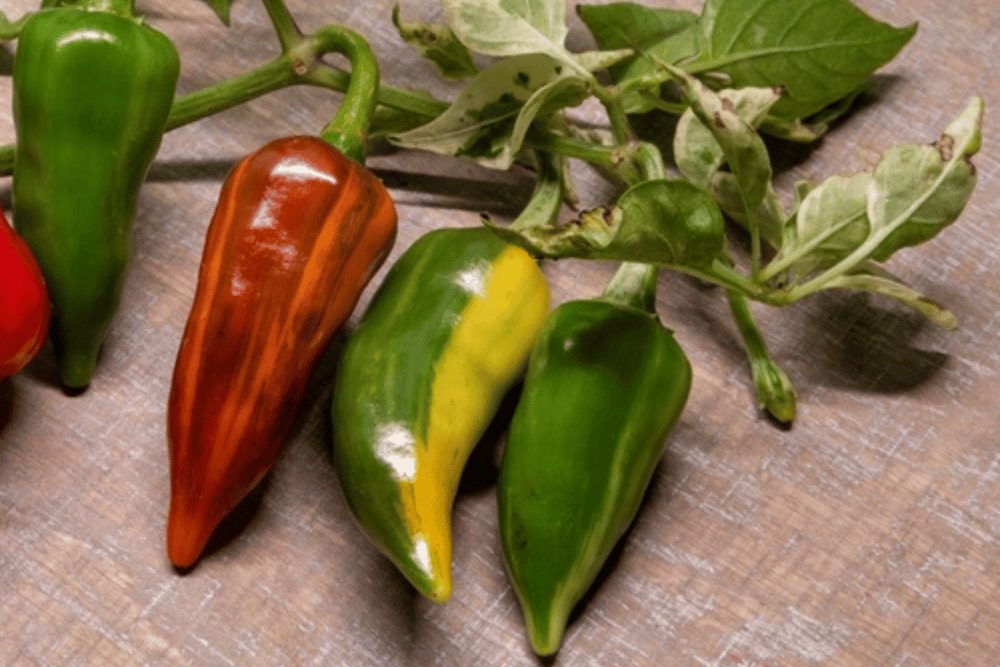Fish pepper is a unique medium-hot chili whose existence is miraculous thanks to African- American culinary heritage. Its white color is invisible in sauces, and fruity, sweet-subtle flavors make it an excellent addition to seafood dishes.
What Are Fish Peppers?
Fish peppers are cultivar plants from the capsicum annuum species. This heirloom pepper variety was popular in the 1800s among African-American populations living in Baltimore and Chesapeake Bay.
The chili was named after what it does best – spicing bland fish, oyster, shellfish and crab dishes in old Baltimore households. This outstanding flavor earned fish pepper a place in the Ark of Taste of Slow Food USA.
Fish peppers contain a recessive gene similar to the ones that cause albinism in humans. One of every fifty fish peppers is pale white due to chlorophyll deficiency. The chilis have a close link to serrano and cayenne peppers.
A fish pepper plant is fascinating to watch. The unique white/grey patches on leaves and fruits changing colors at every ripening stage make it ideal for decorating backyards, gardens, or homes.
Taste
Fish peppers have a bold flavor similar to serranos and jalapeno chilis. They are fruity, tangy, and bright in flavor. Young, green peppers bring a mild flavor, while red, fully-mature chilis produce a deeper, more intense taste.
Texture
This pepper’s outer skin is smooth, thick, and crunchy. Fish peppers are shiny with a soft texture.
Appearance
Appearance is another selling point for fish peppers. The chilis blend colorful pods with beautiful variegated leaves to create an eye-catching look in your kitchen and garden.
Shape
Fish peppers have a conical, pedant-like shape with slightly pointed, tapered, non-stem tips. The pods are curved-straight and broad-shouldered.
Color
Color variations on fish pepper plants depend on maturity stages. Young chilis are white/cream at first before turning into a beautiful light green with white stripes, to streaked orange/brown pods, and finally, a vibrant red color when fully ripe.
Each leaf has a unique color. Some are speckled, while others have a combination of white and green. Further, you may notice leaves with a pure green or an all-white color. This artistic color combination makes the pepper excellent for landscaping.
Size
Despite its unique features and prowess in flavoring cuisines, fish chili is small-sized. It is 2-3 inches long and 0.5-1 inches wide. A mature fish pepper plant grows to a height of 2-2.5 feet with a width of 2 feet.

The Fascinating History Of Fish Peppers – And How They Were Almost Extinct!
The name ‘fish pepper’ came about due to its ability to flavor fish and seafood in African-American communities. These peppers originated from North America’s Baltimore city, through the Caribbean, to Chesapeake bay and Philadelphia.
On arrival, black farmers all over the Chesapeake Bay loved them and started growing them exclusively. The chilis became a secret spicing ingredient for black caterers.
The first documentation dates to the 1800s, but fish peppers were used long before that. This is likely because there were few published black caterers at the time and chefs wanted to keep information about cooking with this pepper a secret.
Towards the 19th century, African-American growers drastically reduced fish pepper farming as they sought to embrace modern lifestyles. This under-production forced the chili’s disappearance to near extinction.
In the 1940s, African-American folk artist/painter Horace Pippin approached renowned beekeeper H. Raph Weaver with an offer to exchange bee stings with rare seeds like fish peppers. Pippin had a painful arthritic injury that required bee stings for relief.
It was in 1995 that historian William Woys Weaver discovered the seeds in his grandfather’s freezer. He loved how productive they were and made them available to the famous Seeds Savers Exchange Yearbook.
Since then, pepper lovers along Chesapeake bay and Baltimore have grown fish peppers in numbers. If you love these delicious chilis, remember they exist by sheer luck!
How Hot Is A Fish Pepper?
A mature fish pepper is hotter than its younger, green counterpart. The chili has medium-hot heat ranging from 5,000 to 30,000 SHUs on the Scoville scale.
While compared to jalapeno peppers (2,500-8,000 SHUs), fish peppers’ heat level is 2-3 times higher. Serrano chilis (10,000-25,000 SHUs) have similar heat to these ornamental peppers.
Its close relative, cayenne pepper (30,000-50,000 Scoville heat units), has almost double the pungency, while habanero peppers are 12-30 times hotter than fish peppers.
Can You Eat Fish Peppers?
Yes. Fish peppers are among the mildly hot peppers great for cooking and landscaping. The thick, crunchy skin makes it delicious when eaten raw. You can also eat a fire-roasted fish chili for more flavor.
How To Use Fish Peppers In Cooking
You’ll be hard-pressed to find a lot of recipes using fish peppers, but they can be used in the same way as any medium-heat pepper. Some ideas include:
- With authentic seafood – Substitute ground white peppers with fish chilis to upgrade the flavor of this seafood gumbo.
- In chicken curry – Including fish peppers in your chicken curry gives it a unique fruity taste.
- Fresh fish pepper salsa – Fish peppers make authentic fish pepper salsa spicy and tasty.
- In fish pepper soup – Make a flavorful, spicy west African soup using fish chilis—and fish!
- Hot sauces – Add fish peppers to make the traditional white hot sauce.
- Pickled fish chili – Pickle your fish peppers and use them on your sandwiches and pizza.
- Eat raw or roasted – Fish peppers are tasty, whether raw or roasted.
- For stuffed recipes – Due to their thick skin, the peppers are excellent for stuffing your favorite foods.
Where To Buy Fish Peppers
These magical chilis are rare. If you’re lucky to live near the Mid-Atlantic regions, fish peppers are available in farmers’ markets and local grocery stores.
The best option to have the peppers is by growing them in a container or in your garden. You can get quality fish pepper seeds online from Amazon or Burpee.
Can You Grow Fish Peppers?
Like other capsicums, fish peppers are easy to grow. They also save space as the chilis grow well in containers.
It’s best to start by growing seeds indoors in a seed tray. With ample water, good rich soil, and lots of sunlight, germination occurs after 7– 21 days.
Wait until the last frost date to transplant the plants. If you live in cold climates, pre-warm the soil by covering it with a plastic bag two weeks before transplanting.
Experts recommend the use of reflective plastic mulch to repel stubborn aphids.
Tip: Avoid planting pure-white seeds as they carry genes that prevent the generation of chlorophyll. Further, thin out all peppers with white leaves before transplanting.
Fish Pepper Substitutes
While fish peppers are rare, there are other peppers you can use to get similar heat and flavor in your recipes. Serrano pepper is the best substitute for fish pepper’s heat and flavor profile.
Cayenne pepper also has a similar taste with a slightly higher spice level. Despite being milder than fish chilis, jalapenos can deliver a flavor closer to that of fish peppers.

